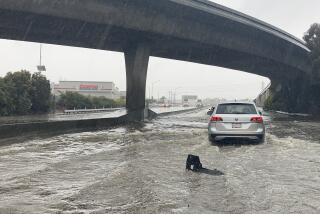Secure a trip with health insurance
Buying travel health insurance before departure is low on many to-do lists, if it’s on the list at all.
But neglecting this task can prove expensive. Medical evacuation alone, including an airlift or other transport when appropriate facilities aren’t available, can cost as much as $100,000.
“The number of people buying these policies has increased because of greater health and safety concerns worldwide,” says Brendan Sharkey, spokesman for insurer HTH Worldwide, www.hthtravelinsurance.com, (888) 243-2358.
“Things happen when on vacation,” Sharkey says, adding that travelers are becoming more realistic. “The recent tsunami in Asia came as a huge surprise to everyone. This is one example of the need for the traveler to expect the unexpected.”
Claudia Fullerton, a spokeswoman for CSA Travel Protection, www.csatravelprotection.com, (800) 348-9505, suggests that travelers review their existing policies to determine what kind of coverage they might be missing on the road. At a minimum, experts say, travelers should determine what gaps need to be filled when abroad.
What you should do before you go:
Review your health policy: Look at your health insurance policy to see what’s covered and what isn’t. Call your member services department, cite your destination and ask specific questions, says Peter Spicer, a spokesman for Chubb, www.chubb.com, (866) 324-8222.
“Ask specifically, ‘Will you do medical evacuation?’ ” Spicer says. Medical evacuation -- in the U.S. or elsewhere -- is a frequent gap in health policies.
Another question to ask: “Does my current health insurance policy cover the expense of seeing a doctor at my destination because of an emergency, such as an accident or a flare-up of an existing condition?”
Basic Medicare generally does not cover medical costs or evacuation overseas.
Check credit cards: Consider other sources of coverage. Many credit card companies offer assistance as part of their benefits.
MasterCard has a free benefit called travel assistance services. But reading the fine print is crucial: The assistance -- such as providing contact information for a network of doctors, dentists, hospitals and pharmacies -- is free, but the fees incurred for services are the cardholder’s responsibility.
Ask specific questions, such as: “Does the service arrange medical evacuation? Does it pay for the evacuation or the medical treatment that follows?”
Shop around: Find a policy that fills the gaps in your coverage, but beware: Travel policies often bundle benefits. A policy may include medical care and evacuation insurance along with such benefits as trip cancellation and interruption insurance.
Follow trends: One trend is higher levels of coverage. Beth Godlin, a spokeswoman for Access America, www.accessamerica.com, (866) 807-3982, says her company’s medical evacuation policy has a $300,000 coverage minimum. HTH Worldwide recently increased its coverage to include more than $500,000 in medical evacuation benefits, although some experts say this is overkill; they say the typical evacuation does not exceed $100,000.
Another trend is the time-limited plans. Some policies cover travelers for an unlimited number of trips during a specified time, rather than just a single trip. Chubb sells a Signature Passport policy that includes as much as $250,000 per person for emergency medical transport to the nearest facility and “excess medical” of $50,000 per person to cover care that your personal health policy does not. The cost is $365 per year for all family members in the household, Spicer says. The policy is designed for affluent travelers who take many trips.
Last-minute coverage is another trend. Some companies sell policies on the Internet just before departure. CSA spokeswoman Fullerton says her company’s policy can be purchased as late as the day before travel. Access America’s QuickTrip Protector is last-minute coverage that doesn’t include trip cancellation insurance but does cover emergency-related medical, dental and transportation services.
Get quotes online: Get free online quotes and shop around. In less than five minutes, you can gather several quotes. Plug in an eight-day, $2,000 cruise to Alaska for a 56-year-old single traveler, for example, and you may see these options: a CSA policy, priced at $49.14, that covers $50,000 in medical or dental expense and $250,000 in emergency assistance; and an Access America plan, priced at $91, that includes $25,000 in emergency medical and dental and $300,000 in emergency medical transportation. (Prices are subject to change.)
Read before signing: Check the fine print and ask questions.
“Be sure to read the certificate of insurance,” advises Sharkey of HTH Worldwide. “You will generally have a 10-day free-look period even after you have purchased the policy. If you don’t like what you read, you can typically return the policy for a full refund, assuming you haven’t left on your trip.”
Look for language that is too restrictive about required pre-certification of a hospital or other care provider, Sharkey says. “Some plans will reduce your benefits by 50% if you don’t contact the insurer prior to getting treatment.”
Ask for specifics about the kind of assistance the policy provides, Sharkey says.
“Some companies may find you an English-speaking doctor but have no other selection standards beyond this language capability,” he says. “Let’s face it: You wouldn’t select a doctor at home just because he or she spoke English.”
Some companies, he says, will pay for visits to Western-trained doctors in different specialties.
More to Read
Sign up for The Wild
We’ll help you find the best places to hike, bike and run, as well as the perfect silent spots for meditation and yoga.
You may occasionally receive promotional content from the Los Angeles Times.






